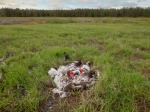Chris Jordan’s message from the gyre
by criedy
I’ve been an admirer of Chris Jordan’s digital photographic art for several years now. HisRunning the Numbers series paints an unflattering portrait of American and global consumer culture that presents environmental messages in a fresh light. He creates images using repetition of familiar consumer items and waste, typically with an ironic twist. For example, below is his work ‘Whale‘ from 2011.
What at first glance seems to be a nice picture of a whale turns out to be something more sinister. The work is constructed (digitally) from 50,000 plastic bags, equal to the estimated number of pieces of floating plastic in every square mile in the world’s oceans. The website allows you to zoom in to see the individual plastic bags, as shown in the view below of the whale’s eye. It’s a sad indictment on the state of the Earth’s oceans.
On Midway Atoll, a remote cluster of islands more than 2000 miles from the nearest continent, the detritus of our mass consumption surfaces in an astonishing place: inside the stomachs of thousands of dead baby albatrosses. The nesting chicks are fed lethal quantities of plastic by their parents, who mistake the floating trash for food as they forage over the vast polluted Pacific Ocean.
For me, kneeling over their carcasses is like looking into a macabre mirror. These birds reflect back an appallingly emblematic result of the collective trance of our consumerism and runaway industrial growth. Like the albatross, we first-world humans find ourselves lacking the ability to discern anymore what is nourishing from what is toxic to our lives and our spirits. Choked to death on our waste, the mythical albatross calls upon us to recognize that our greatest challenge lies not out there, but in here.
~ Chris Jordan, Seattle, February 2011
In 2009, Jordan began travelling to Midway Atoll, in the middle of the Pacific Ocean, 2,000 miles from the nearest continent. What he found and photographed there is sickening. Inside the stomachs of dead baby albatrosses he found deadly plastic waste from human civilisation that had found its way even to this remote place.
The photographs he took are macabre and disturbing. These intimate portraits of death by plastic are strangely beautiful, yet behind each photograph is a story of pain and suffering that tears at your heart. I’ve included a selection of his photographs below.
Jordan is currently working on a film about his experiences on the island, called Midway. The trailer is below. I find it even more haunting than the images, because it shows the pain that lies unspoken in the photographs. If anyone ever doubts the impact that humans have on the Earth, show them this trailer and these images. Our civilisation brings death even to this remote part of the globe. We must find new ways to live with our beautiful planet that work with the Earth’s systems, not against them. For some people, this artwork will bring that message home more powerfully than words ever can.
Related articles
- Chris Jordan’s Midway Film Project (Video) (americanlivewire.com)
- Shocking new film captures plastic’s legacy (mnn.com)
- More than 2000 miles from the nearest continent (wearechangevictoria.org)
- The Midway media project (carolinageorgatou.com)
- Baby Albatrosses and plastic waste (hikingartist.com)
I’ve been an admirer of Chris Jordan’s digital photographic art for several years now. His Running the Numbers series paints an unflattering portrait of American and global consumer culture that presents environmental messages in a fresh light. He creates images using repetition of familiar consumer items and waste, typically with an ironic twist. For example, below is his work ‘Whale‘ from 2011.
What at first glance seems to be a nice picture of a whale turns out to be something more sinister. The work is constructed (digitally) from 50,000 plastic bags, equal to the estimated number of pieces of floating plastic in every square mile in the world’s oceans. The website allows you to zoom in to see the individual plastic bags, as shown in the view below of the whale’s eye. It’s a sad indictment on the state of the Earth’s oceans.
On Midway Atoll, a remote…
View original post 351 more words











